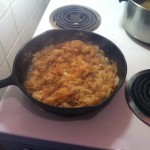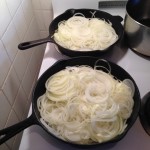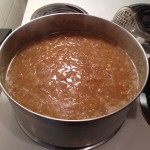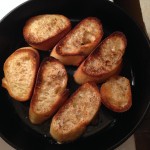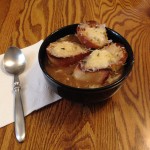This Meatless Monday, we feature onions, with growing, storage and prep tips, as well as recipes for French Onion Soup and Carmelized Onions from Vermont Fresh: A Fruit and Vegetable Handbook.
Background
It is believed that onions have been used by humans for many thousands of years, since well before the start of recorded history. One of the first cultivated crops, onions are probably native to Central Asia, but they have been so widespread for so long that experts are unsure where precisely the pungent bulbs originated. Evidence suggests that as long as 4,000 years ago, onions were a common, cultivated source of food from Egypt to China. Today, onions can be found in the cuisine of almost every culture across the world. Onions are popular for good reason: they are easy to grow, cheap to buy, can store well into the winter, and add a wealth of flavor to almost any dish. Modern onions can be found in over 300 varieties and are available in many different colors, shapes, and sizes.
Growing Tips
Onions can be started either from seeds or from “sets,” pre-started little onions that you can purchase at many nurseries or hardware stores. Onions grown from sets will mature sooner but tend not to store as well. Quite cold-hardy, onions (either seedlings or sets) can be planted as soon as the soil can be worked, but be sure to plant in full sun—shade will result in very small bulbs and slow growth. If starting from seed, begin indoors in April and plant outside in mid- to late-May. When seedlings reach 5 inches in height, trim the greens down to 1-2 inches. This will ultimately result in larger bulbs. If planting sets, be sure to plant root-end down. Onions need rich, well-drained soil and to be weeded often. Harvest when tops have dried down (or sooner for “green onions,” but these will not store well) and before fall frosts set in. Onion greens can be used as herbs, too.
Storage
Choose onions that are dry and firm, without soft spots or any evidence of sprouting. Onions should be stored in a cool, dry, dark place. Take care to store them away from other foods, as their smell can be invasive. Once an onion is peeled and cut, refrigerate and use soon as it will spoil within a week. Green onions should be refrigerated, too.
Nutritional Benefits
Onions contain chromium, a trace mineral that helps the body maintain normal insulin and blood sugar levels. Red and yellow onions also have quercetin, a flavonoid that inhibits the formation of cancer cells. On top of that, onions contain about 150 different phytochemicals!
Preparation
Onions are incredibly versatile and can be sautéed, baked, roasted, grilled, steamed, or eaten raw. Onions are integral to many soups and sauces. Unless a recipe says otherwise, onions are always peeled before use: use a sharp chef’s knife and cut off the neck and root ends before pulling off the tough outer skin.
Meatless Monday Recipe: French Onion Soup
Michael Cunningham and Karlie Intlekofer, volunteers cooking, tasting and testing recipes out of the Vermont Fresh Handbook tried out these two recipes. Their comments are in italics below.
- Photo courtesy of Michael Cunningham and Karlie Intlekofer
- Photo courtesy of Michael Cunningham and Karlie Intlekofer
- Photo courtesy of Michael Cunningham and Karlie Intlekofer
- Photo courtesy of Michael Cunningham and Karlie Intlekofer
- Photo courtesy of Michael Cunningham and Karlie Intlekofer
- Photo courtesy of Michael Cunningham and Karlie Intlekofer
Serves 6
(adapted from Gourmet, January 1991, and epicurious.com)
Ingredients
- 1 stick butter
- 5 large onions, thinly sliced
- 2 teaspoons garlic
- 1 tablespoon flour
- 6 cups beef broth (make it meatless with veggie broth)
- Salt and pepper to taste
- ½ loaf French bread, cut into ½ inch-thick slices
- 1 cup grated Gruyère (or other cheese of your choice)
Instructions
- Melt butter in a large pot over low-medium heat.
- Add onions, cover, and cook, stirring frequently, until golden and tender, about 30-40 minutes.
- Add garlic and sprinkle mixture with flour. Cook another 3 minutes, stirring constantly.
- Add the broth and bring to a boil. Reduce heat and simmer, covered, for up to an hour or until onions are meltingly soft. Add salt and pepper to taste.
- While soup is simmering, lightly toast the bread slices on a cookie sheet in oven at 350°F. Watch carefully as they will brown quickly. After removing bread, turn oven up to 450°F.
- Pour soup into several oven-proof bowls and place the bowls on a rimmed baking sheet.
- Top each bowl of soup with 1 or 2 slices of the crisped bread, then sprinkle cheese atop each. Transfer baking sheet with bowls to oven and bake about 4 minutes, until cheese is bubbly. Serve hot.
French onion soup recipe tips and advice
- Ingredients cost roughly $30 (cheese was most expensive ingredient per pound)
- Prep time: less than 15 minutes with a mandoline
- Total cook time: 1 ½ hours
Tips:
- Use a food processor or mandoline to slice the onions with ease and to ensure uniform thickness
- Cooking the onions is accelerated with multiple skillets due to increased cooking surface area
- May consider reduced sodium beef broth as some brands are extremely salty.
- Gruyère cheese is expensive and can be substituted with a similar cheese for those on a budget.
- Moving hot boils of soup in and out of a 450-degree oven is tedious and difficult; instead: slice the bread, top generously with butter , drizzle with olive oil and then oven toast at 300 for at least 5 minutes. Once toasted, top bread with shredded Gruyère and parmesan cheese, then broil for a couple of minutes until browned on top. Top hot soup with these delicious cheesy bread pieces. This eliminates the need to move full bowls of hot soup in and out of the oven and also prevents a soggy or mushy bread topping.
- Serves 6
- The taste was savory and delicious, and the dish was quite filling.
Meatless Monday Recipe: Caramelized Onions
Serves 6
Ingredients
- 2 large onions, preferably not a “sweet” variety
- 2 tablespoons olive oil
- 1 teaspoon salt
- 1 tablespoon cider vinegar (optional)
Instructions
- Peel onions and carefully chop them into ¼ inch-thick rings.
- Pour enough of the olive oil into a heavy skillet to cover the bottom of it. Turn heat to medium.
- Place onions in pan and toss to coat in the oil. Allow to cook undisturbed for about 5 minutes, then toss them. Allow to cook for another 5 minutes without stirring, then add salt and toss again. Continue to toss every 5-10 minutes as the onions soften and brown.
- When onions are beginning to color, remove from heat temporarily, stand back, hold your face away, and add vinegar (careful—it will be steamy and might splatter).
- Toss to coat onions, return to heat, and allow to cook down to desired consistency.
- Note: if you wish to add minced garlic, do so only in the last 5 minutes, as it will cook very quickly. Caramelized onions are a great addition to sandwiches, pizzas, sauces, and salads.
To receive more recipes and tips on your favorite fruits and vegetables, download Vermont Fresh: A Fruit and Vegetable Handbook. We also need more volunteer home chefs for this project.
Vermont Foodbank fresh food initiatives would not be possible without your support. Please consider giving to the Vermont Foodbank today!


